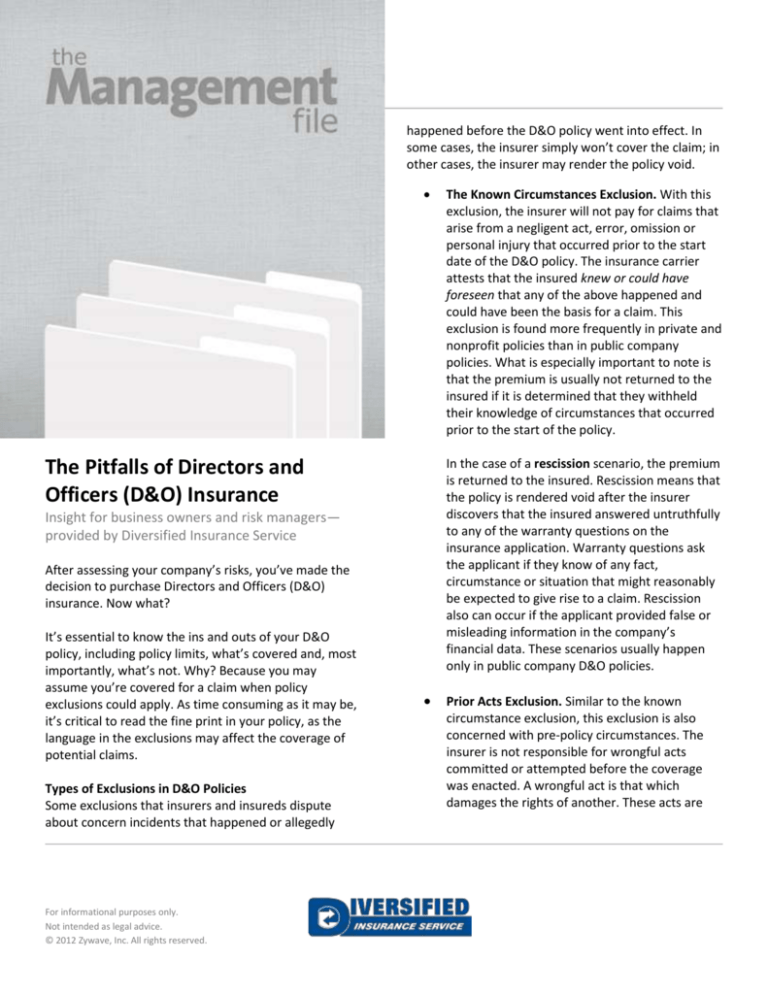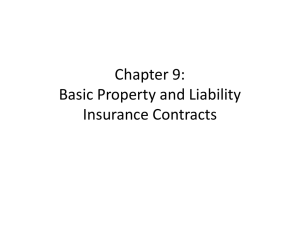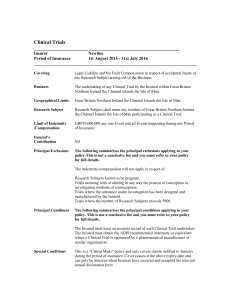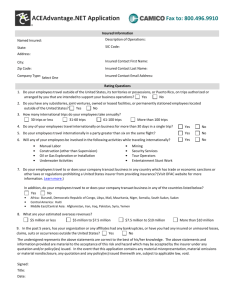
happened before the D&O policy went into effect. In
some cases, the insurer simply won’t cover the claim; in
other cases, the insurer may render the policy void.
The Pitfalls of Directors and
Officers (D&O) Insurance
In the case of a rescission scenario, the premium
is returned to the insured. Rescission means that
the policy is rendered void after the insurer
discovers that the insured answered untruthfully
to any of the warranty questions on the
insurance application. Warranty questions ask
the applicant if they know of any fact,
circumstance or situation that might reasonably
be expected to give rise to a claim. Rescission
also can occur if the applicant provided false or
misleading information in the company’s
financial data. These scenarios usually happen
only in public company D&O policies.
Insight for business owners and risk managers—
provided by Diversified Insurance Service
After assessing your company’s risks, you’ve made the
decision to purchase Directors and Officers (D&O)
insurance. Now what?
It’s essential to know the ins and outs of your D&O
policy, including policy limits, what’s covered and, most
importantly, what’s not. Why? Because you may
assume you’re covered for a claim when policy
exclusions could apply. As time consuming as it may be,
it’s critical to read the fine print in your policy, as the
language in the exclusions may affect the coverage of
potential claims.
Types of Exclusions in D&O Policies
Some exclusions that insurers and insureds dispute
about concern incidents that happened or allegedly
For informational purposes only.
Not intended as legal advice.
© 2012 Zywave, Inc. All rights reserved.
The Known Circumstances Exclusion. With this
exclusion, the insurer will not pay for claims that
arise from a negligent act, error, omission or
personal injury that occurred prior to the start
date of the D&O policy. The insurance carrier
attests that the insured knew or could have
foreseen that any of the above happened and
could have been the basis for a claim. This
exclusion is found more frequently in private and
nonprofit policies than in public company
policies. What is especially important to note is
that the premium is usually not returned to the
insured if it is determined that they withheld
their knowledge of circumstances that occurred
prior to the start of the policy.
Prior Acts Exclusion. Similar to the known
circumstance exclusion, this exclusion is also
concerned with pre-policy circumstances. The
insurer is not responsible for wrongful acts
committed or attempted before the coverage
was enacted. A wrongful act is that which
damages the rights of another. These acts are
not only limited to criminal offenses, but can
also include acts that result in civil lawsuits.
Other exclusions found in D&O policies revolve around
the duty to defend and defense expenses in the event
of a claim. If the insurer has the right to the duty to
defend, then they are able to select the insured’s
defense and have greater control over the rates and
billing practices of the defense counsel.
Reasonableness of Defense Fees. This is more
prevalent in private company and nonprofit D&O
policies, as most of those policies give the
insurer the right and duty to defend the
insured’s claims; whereas, public companies
retain the right to choose their own defense
counsel. If this is written into your D&O policy, it
means that the insurer will only pay for
“reasonable and necessary” defense fees. Some
insurers also provide detailed information on
litigation guidelines.
Consent to Settle and the Hammer Clause. If the
insurance carrier has no duty to defend, such as
in cases against public companies, then they
have no right to settle the case when they want
to settle it. As a result, the insured may elect to
continue with litigation, even if that would
exhaust the policy limit, because the defendants
don’t want settling the case to be perceived as
an admission of their wrongdoing or
incompetence. This creates a lot of tension
between insurers and the insured, especially if
the insured does not include the insurer in the
settlement discussion. Therefore, some
insurance policies have a consent to settle
exclusion in the policy, prohibiting the insured
from settling the claim without the insurer’s
prior written consent.
The hammer clause is similar to the consent to
settle exclusion, although less common.
Basically, the hammer clause informs the insured
that if they go against the insurer’s
recommendation to settle, the insured will be
responsible for any judgment won by the
plaintiff plus legal fees that go beyond the
settlement offer.
Most D&O insurers expect that D&O insurance is only a
part of a company’s wider insurance portfolio. In some
cases, however, this assumption doesn’t always prove
to be true. Certain firms may go without Umbrella
insurance or even General Liability insurance policies,
making D&O one of their only forms of insurance.
Because of this, many D&O insurers write exclusions in
their policies stating what claims they won’t cover
because other types of insurance would potentially
cover the claim.
“Other Insurance” Exclusions. D&O insurance is
just one form of insurance in a comprehensive
risk management plan for most companies.
Because of this, most D&O policies have
exclusions for claims that involve bodily injury,
property damage and Employee Retirement
Income Security Act (ERISA) claims, which could
be covered by other types of insurance such as
a Commercial General Liability policy or a
Fiduciary Liability policy. To protect their best
interests in the event of a claim, the insured
should notify all insurers from their various
policies, thus allowing the insurers to determine
who is liable for the claim.
Contractual Liability Exclusion. This exclusion is
especially pertinent to private companies and
nonprofits that have broad entity coverage
under a D&O policy. Since contractual
obligations are not liabilities imposed by law
but rather an obligation that is voluntarily
undertaken, many D&O policies have an
exclusion that prevents insurers from having to
cover contract-related claims, especially
2
breaches of contract that arise when the
company enters into a contract with another
party.
When examining this exclusion in your D&O
policy, make special note of the wording of this
clause. This exclusion can substantially affect
the extent of your coverage under the policy—
the narrower the scope of the exclusion, the
better for you.
insured vs. insured claims if the whistleblower is
also one of the insured directors.
Obtaining D&O insurance is important to protect the
directors and officers of your company; but simply
purchasing the policy won’t benefit you unless you
know the extent of your coverage.
Do you understand your D&O insurance policy? Contact
Diversified Insurance Service today for more
information about your coverage and exclusions.
D&O insurance protects directors and officers from
poor business decisions, but most policies do not
protect them from wrongful acts and gross misconduct.
These exclusions include:
Conduct Exclusions. Most D&O policies have
exclusions that deny coverage for certain types
of misconduct. There are two categories of
misconduct exclusions:
1. For loss relating to fraudulent or criminal
conduct
2. For loss relating to illegal profits or
remuneration to which the insured was not
legally entitled
It’s especially important to look at the wording
on these exclusions in the policy; subtle
wording differences can significantly impact the
accessibility of the coverage.
Insured vs. Insured Exclusion. In some D&O
cases, one insured director may bring a claim
against another insured director, and some
insurers do not want to cover this because they
don’t want to get involved in the infighting
between a company’s directors and officers.
However, with recent changes to the
whistleblower provision of the Dodd Frank Act,
most insurers are now agreeing to cover
3








